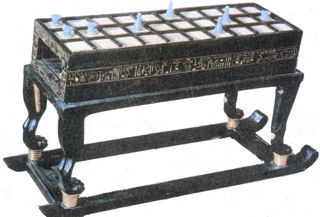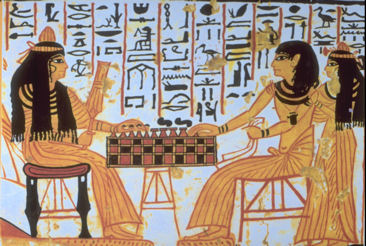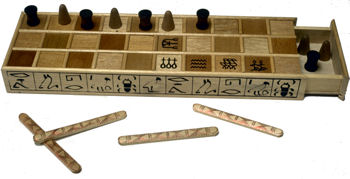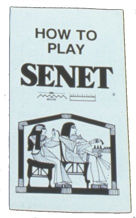
This elegant looking game board (pictured on the left) is made of ebony, ivory, lapis, and gold, and was found in King Tut's tomb, along with a number of other games of this type. Tut died about 1350 B.C., nevertheless, Egyptologist indicate that a version the game of Senet was probably played in Egypt prior to 3000 B.C. Archaeologists report that board games first appear about 9000 B.C., and Senet may be an evolved type of these very early board games.
Click on the left menu item above to read a scholarly paper written in 1980 about this game and some of interpretations concerning it over the years. Archaeologists and Egyptologist have been excavating Egyptian tombs for more than a hundred years, and have unearthed a great deal of information about the game of Senet. While there are no written instructions for play of the game that have survived the millenniums that it has been played, there are many types of "evidence" that have enabled Egyptologists to explain how the game can be played.

This evidence is in the form of many wall paintings in tombs illustrating people playing the game, papyrus scrolls which include information about the game, and of course, some hieroglyphic evidence. Since the game was played in the mid-east into the early A.D. centuries, there are findings about the game during those times.
Archeological findings from different periods range from the elaborate board such as found in Tut's tomb, to simple baked clay tablets. This range of materials suggests that people of all social classes played Senet.

When the Museum moved into new quarters on the University campus in the mid-1970s, it borrowed the Senet game (on the left) from the Royal Ontario Museum (ROM) for an exhibit. The "board" was not a board as such, but 30 preserved earthen tiles held in a wooden frame built by the ROM. The game pieces (that the ROM provided) were similar to ones that would be used for Senet, but were from another archaeological find. The ROM's arrangement of the tiles was appropriate, since in the main, a "standard" Senet board consisted of 30 tiles arranged in 3 rows of ten. In almost all of the Senet "boards" found, only the last five squares (bottom row) as in the ROM board, contain etched hieroglyphics on their top faces. All the other tiles are usually blank.

What do these hieroglyphics say, and what do they say about the play of the game? It is assumed by Egyptologist that the hieroglyphics have something to do with the play of the game, and are not just decorative. Since Senet is thought to be a game in which two player's race to complete a course on a track, the last five tiles either impede or increase a player's change of winning. This is much like in a contemporary game in which a player lands on a square that says "back up 3" or "advance 7 spaces". As in most "racing games on a track" some chance device is required by players to indicate how many moves they can make on the track during each turn. In contemporary games, dice are often used for this purpose. In Senet a set of "throw sticks" were used by players as a chance device.

In 1979 the Museum acquired the reproduction of the Senet game pictured on the left. As in more elaborate ancient sets, this reproduction has a drawer in the base to hold the playing pieces and the throw sticks. The reproduction was manufactured by Northwest Corner, a company in Seattle, Washington, U.S. The board (box) is made of wood and is 13cm long x 41.5cm wide x 4.6cm high. The top is divided into 30 squares, 3.5cm each and each is surrounded by molding.

The set includes a booklet with a history of the game and instructions for a number of ways the game might be played.
According to the manufacturer, this version is a pre 18th Dynasty version from Egypt, and thus the 5 hieroglyphics are placed as in that original game with one in the middle of the board, and four in the third row.
The wooden playing pieces are shaped like spools (2.4cm high) and cones (2cm diameter x .3cm high) There are 5 of each in the set. The four wooden "throw sticks" are 10.6cm long x 1.6cm wide x .6cm high. Each stick has a rounded embossed and painted top, and a plain underside.
There are many published references to the game of Senet. Here are a few:
H.J.R. Murray, A History of Board-Games Other Than Chess, Oxford 1952.
R.C. Bell, Board and Table Games from Many Civilizations, Oxford, 1969.
David Parlett, Oxford History of Board Games, Oxford, 1999.
Irving Finkel, Five Ancient Games, The British Museum, 2005.
Last update January 5, 2010